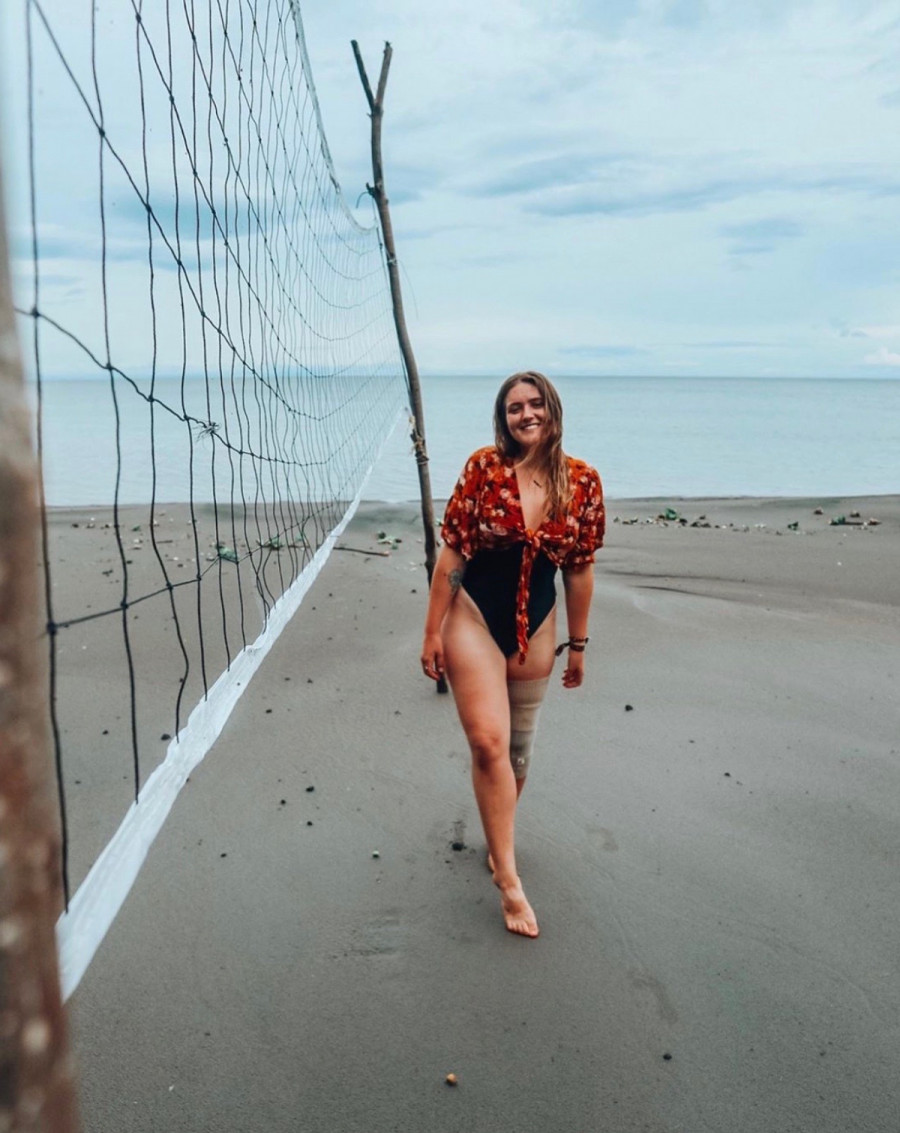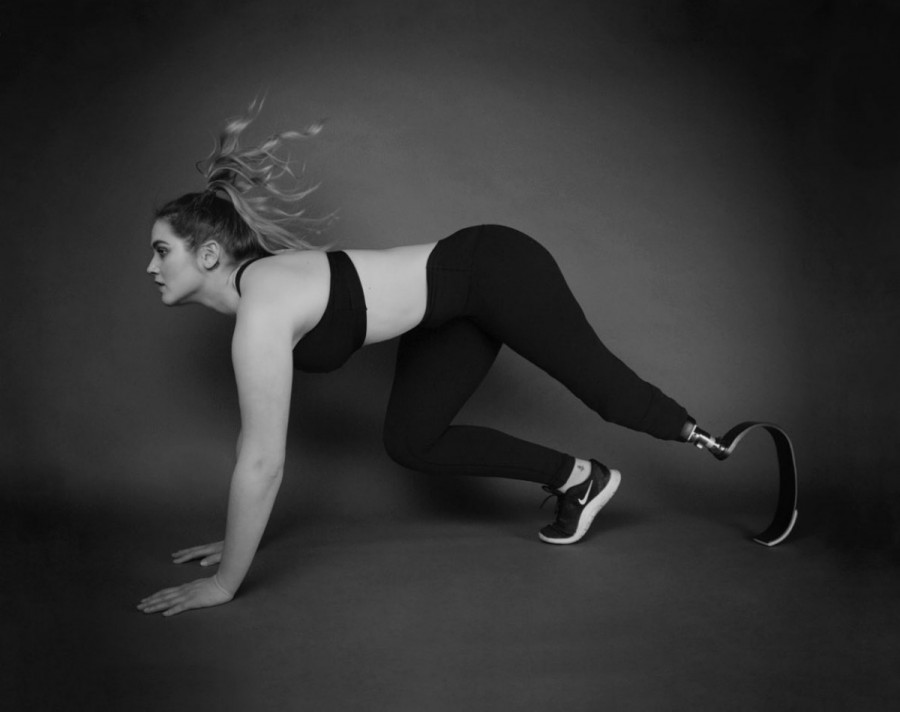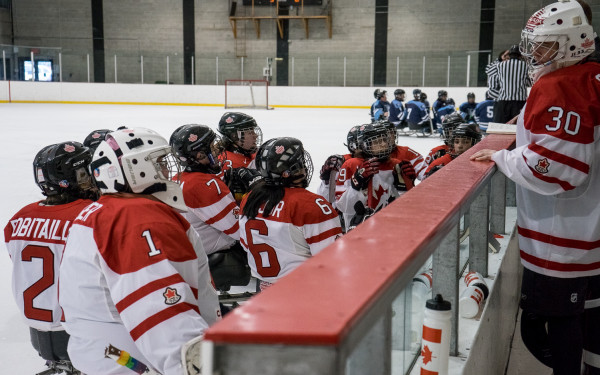How a Hopeful Paralympian’s Disability Has Become Opportunity
‘Hop Around the World’ with Allison Lang
“I actually have more legs than you.”
That’s Allison Lang’s answer whenever someone teases her about her amputated leg. And technically, she’s right.
Lang has four different prosthetic legs to go along with her healthy one: she has an “everyday” leg, a snowboarding leg, a swimming leg and a running leg. And there are plenty more where those came from.
“If you were to look into my parent’s basement back home, you’d find boxes full of my old legs,” she joked. “You can line them up by size and see them get taller and taller to fit me as I got older.”
Some of the 26-year-old’s current challenges around her prosthetic leg have to do with the high humidity levels of Canadian summer heat, or struggling to find shoes she can fit her plastic foot into.
At first glance, Lang’s disability is hardly noticeable, and it certainly doesn’t get in the way of her living her life to the fullest.
On one and half legs, Lang has earned two university degrees, successfully surfed and even descended into an active volcano, just to name a few of her accomplishments so far.
By the end of 2021, she hopes to add “Paralympian” to that impressive list.
Lang, born and raised in Edmonton, was born missing the lower half of her left leg, despite there being no early evidence of the issue in the ultrasounds performed leading up to her birth.
Doctors amputated a mass “the size of a pinky finger” off the end of her stump, to allow Lang to fit into prosthetics when she got older.
Her left knee cap is significantly smaller than her right, with a small muscle making up her stump. Despite not having much control over that part of her body, she considers herself lucky to have the mobility and flexibility to be active.
“Growing up, my parents put me in soccer and swimming, and I even did some skiing,” she said. “My disability didn’t really hinder my childhood as much as people expect it would.”
But while sports made her feel just like every other kid, her classmates were quick to remind her that she was different.
“I was called ‘peg leg’ and ‘Barbie’,” she recalled. “I would be pushed over in the playground, or they would take my prosthetic from me and run away.”
Her parents, well aware of their daughter’s trouble at the hands of bullies, went to the elementary school’s principal to put an end to the situation.
His response?
“Well, girls will be girls.”
Nothing changed, so when it was time for Lang to move on to middle school and eventually high school, she decided to make sure no one could find out about her disability.
“I thought it was perfect, that it would be like a fresh start,” she said. “I never wore shorts, no matter how hot it got, and I never wore open-toed shoes so that my friends couldn’t see that my foot was fake.”
If anyone noticed her slight limp, she’d always come up with a different excuse, like how she fell off her skateboard or hurt her knee snowboarding.
It wasn’t until her high school graduation, when Lang wore a short dress under her gown, that she finally decided to reveal her disability to her peers.
“That was like the biggest deal for me,” she said. “After that, there was no turning back.”
“Growing up, my parents put me in soccer and swimming, and I even did some skiing. My disability didn’t really hinder my childhood as much as people expect it would.” – Allison Lang
As she began university and life as an adult, Lang finally felt more comfortable in her skin and embraced her differences.
Around the same time, she was introduced to sitting volleyball, the alternative for volleyball for athletes with disabilities. Invented in 1956 as a rehabilitation sport for injured soldiers, it made its first paralympic appearance in the 2004 Summer Games in Athens.
A sitting volleyball court is 10 by 6 metres, with a seven-metre long and 0.8-metre wide net. For comparison’s sake, a regular volleyball court is 18 by 9 metres, with an 11-metre long and one-metre wide net.
It shares the same rules as regular volleyball, with the exceptions that a player must always be in a seated position when they make contact with the ball, and blocks are permitted on serves.
A friend Lang knew through the War Amps program, familiar with her participation in sports during her childhood, invited her to the Canadian women’s national sitting volleyball tryouts, taking place in her hometown of Edmonton.
Despite having no background in volleyball, Lang decided to give it a try.
“At this point, the team for women was only two years old, so it was really just starting,” she said. “When I showed up, there was a coach, a physiotherapist, and only five other players.”
Even with her athletic background, Lang initially struggled with this new sport.
“I sucked at first, to be honest,” she said, laughing. “I couldn’t set, I couldn’t serve, and I had never played a sport where I had to be sitting down the whole time!”
The pace of the game, faster than that of standing volleyball due to the smaller playing surface and closer proximity of players, makes for a fascinating medley of lunges and movements that the average athlete rarely resorts to. Rallies are similar to those seen in standing volleyball, with most points won off of deflections and blocks at the net.
“You use muscles you wouldn’t think would ever be so important,” Lang said. “You have to keep an eye on the ball while you push yourself across the floor with your hands, which you then have to use to keep the ball in play, and then get back in position.”
In a matter of months, Lang and her team were flying around the world, competing in tournaments and Olympic qualifiers. In 2011, her team was agonizingly close to a birth onto the sport’s biggest stage, coming within one set of qualifying for the London 2012 Paralympic Games.
“That was one of the most devastating times of my life, just because of how hard we worked to get there,” she recalled. “We watched our team grow from four players to 10-12 players and went through so much with the program to get to that point.”
A year away from getting her graphic design and photography degree from MacEwan University, Lang decided to leave the team to focus on school.
“I was slacking on my fitness levels to focus on my schoolwork, and I felt like I couldn’t properly commit to either one,” she said. “I just made the executive decision to pull out of volleyball and focus on finishing school and starting a career.”
While she returned to school, this time pursuing an education degree from the University of Alberta, Lang played a bit of recreational volleyball on a team with her co-workers at the time.
She travelled and kept in shape, snowboarding, swimming, and working out regularly. Eventually, she got her teaching degree and moved to Montreal, where she currently lives.
But the itch for sitting volleyball never went away.
“I had been thinking about going back ever since I left,” she said. “I followed the team from afar, watching their games and seeing them win a gold medal at a tournament in Halifax. That made me so happy for the girls and just made me miss it more.”
Then, in early 2020, Canada and the rest of the world was hit with the COVID-19 pandemic, grinding society to a halt and postponing many public events, like the summer Olympics in Tokyo.
While most of the world sat stuck at home in quarantine, social media sites like Instagram and Twitter were abundant with different challenges and initiatives, hoping to ease the mental and social strain the pandemic was putting on everyone.
One day, Lang was challenged to do 10 sets with a volleyball. She didn’t own a volleyball at the time, so she opted to use a toilet paper roll instead, a hot commodity at the start of quarantine.
As she passed along the challenge to other friends, people took notice.
“When she saw my post, the current coach of the team jokingly asked if I was out of retirement yet,” she said.
While she was eager to get back to playing sitting volleyball, Lang didn’t want to bandwagon on the team, taking advantage of the looming Paralympic Games, now taking place in 2021 due to the pandemic, to get herself back onto the team for a shot at competing on the world stage.
“I like to think I have a good moral compass,” Lang said. “I would never want to join last minute just for the perk of going to Tokyo. I want to feel like I earned my spot.”
But the coach was quick to downplay this thought, assuring Lang that her skills and height — 5-8 — would be very useful to the team in their run to the tournament.
So, in the middle of a global pandemic, Lang has found herself training with her former teammates again, albeit from afar. The coaches have put her on the team’s workout program, monitoring her progress and work through a software program called Kinduct.
The big challenge has been finding spaces and resources to train.
“It’s tough because in the middle of a pandemic, I don’t have access to a gym floor to properly practice on,” Lang said. “It’s been frustrating because there are so many limitations right now when it comes to preparing myself.”
The team is hoping to begin training together as a group by the beginning of fall. The players are already being briefed on the preparations and measures that will be taken to create as safe an environment as possible.
“We’ll be sent coronavirus tests as soon as we land to make sure we’re all healthy,” Lang said.
“The balls we use will have to be disinfected and alternated while we practice. We’ll also have the option of wearing masks while we play.”
While early training camps are optional for the players, Lang is determined to attend them, ready to make a good impression on her coaches and teammates.
“On paper, I’m not an official member of the team,” she said. “Volleyball Canada has to see me perform and play so that they can include me on the team and register as an official athlete.”

When she’s not busy setting a volleyball against a wall or working on her core strength to get around the court, Lang spends a lot of time interacting with over 7,000 followers on Instagram.
Scrolling through her Instagram page, you’ll find tons of pictures from trips and activities she takes part in, as well as a plethora of posts including a growing number of sponsorships.
“I feel weird about the term ‘influencer’ because that was never really my intention,” she said. “I think I just wanted to use my platform to show people that I can really do anything everyone else can.”
Lang credits the strong following she’s created on social media to her love for photography and travel. The rest has come from her developing confidence and self-appreciation.
“I used to be insecure and uncomfortable, and I could never see myself doing this kind of thing when I was younger,” she said. “It wasn’t until my early twenties when I really developed a sense of who I was and what I wanted to do with my life.”
Lang’s social media platform took on a new meaning when fellow amputees and relatives of people with disabilities started reaching out to her.
“I started getting messages from mothers who had children with physical disabilities,” she said. “That made me realize that I’m having a positive effect that matters on people who face similar challenges to mine.”
At 26 years old, Lang has backpacked through 29 countries on her own, and been on beaches and mountains around the world. The hashtag that accompanies most of her travel posts, #HopAroundTheWorldWithMe, summarizes her ambitions and lifestyle almost perfectly.
Yet, her goals reach even further than Instagram popularity or becoming a Paralympic athlete. Lang would also like to create change in Canada’s disability community as well.
As a kid and young adult, Lang could rely on the War Amps for support and her needs relating to prosthetics. The Champ program, which stands for “child amputees”, raises money to cover recreational limbs for children, which Lang used for sports and various activities growing up.
But now that she’s passed the age of 25, when the War Amps cease to sponsor amputees, she’s found that support systems are few and far between for Canadians with disabilities like hers.
That’s something she intends to change.
“Adults are only granted a new prosthetic every four years,” she said. “The last leg I had made cost $15,000, which is like buying a car. That’s not always feasible for people who maybe broke their prosthetic or need a new one made on short notice.”
The transition from War Amps’ sponsor to adult for amputees like Lang is tough, with no organization to lean on.
“What I’d like to do in the future is create a sort of support group for people with disabilities,” she said. “My dream would be to get people like me together and have discussions to help these people who can’t really get that same support elsewhere.”
Growing up, one of the most common questions she was asked was whether she wishes she was born with two legs. The answer has changed throughout her life, but she’s settled on one for good.
“No, because I would never have had the opportunities I’ve gotten if I had both my legs.”


_600_832_s.png)

1_600_375_90_s_c1.jpg)
2_600_375_90_s_c1.jpg)
1web_600_375_90_s_c1.jpg)
